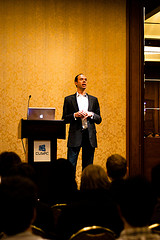Ineffective leadership may be slowly poisoning your organization.
And you may not even be aware of it.
Imagine an organization where the best employees regularly leave. Those who stay spend too much time on non-critical tasks. They don’t look forward to coming to work and are eager to flee the workplace at the end of the day. They fear, rather than respect, their managers and don’t bring issues or suggestions to them. This emotional angst leads to worry, and sometimes to alcoholism or drug use in order to feel better for a while. Productivity is low, and morale is even worse.

“Organizations usually have a few great managers, some capable ones, a herd of mediocre one, some poor ones, and some awful ones.” (from Being the Boss: The 3 Imperatives for Becoming a Great Leader by Linda Hill and Kent Lineback)
Could that be true for your company? At least, perhaps, in some areas? Even your own? Look more closely, because you may be surprised.
“According to Gallup, only 30% of employees actively apply their talent and energy to move their organizations forward. Fifty percent are just putting their time in, while the remaining 20% act out their discontent in counterproductive ways. Gallup estimates that the 20% group alone costs the U.S. economy around half a trillion dollars each year. A main cause of employee disengagement is poor leadership, Gallup says.” (from Blue Ocean Strategy by W. Chan Kim and Renee Mauborgne)
It may be hard to spot an ineffective leader. They could be hiding in plain sight–they might even be your hardest charger or top performer! But the people under them are scared and unhappy, because their workplace has become toxic.
Ineffective Leadership Weaknesses
If you look more closely, you can better identify ineffective leadership:
 Ineffective leaders are controlling.
Ineffective leaders are controlling.
- Dictatorial in style, often micro-managing their employees.
- Not open to input, manipulating situations to drive their agenda.
“A leader is someone who gets things done through other people.” (Warren Buffett)
Ineffective leaders can be prideful.
- Ego-oriented, lacking in both humility and self-awareness.
- Blind to their own weaknesses, often repeating mistakes over and over.
“Chief among (workplace issues) is failure of leadership, often by high achievers unaware of uncaring about their own limitations. The painful realities of toxic bosses are compounded by what researchers call ‘CEO disease.’ The term describes the obvious – no one wants to tell the boss bad news, let alone tell him he’s a jerk.” (from Rising Above a Toxic Workplace by Gary Chapman, Paul White, and Harold Myra)
 Ineffective leaders may be disempowering.
Ineffective leaders may be disempowering.
- Unempathetic to people’s feelings and unforgiving when mistakes are made.
- Do not connect well with others or maintain effective win/win relationships.
“A lack of connection between management and employees breeds distrust, cynicism, and apathy.” (Paul White)
Ineffective leaders are often perfectionists.
- Heads-down focus with limited emotional or spiritual awareness.
- Create stress by being too exacting rather than applauding progress.
“We all know that perfection is a mask … The people with whom we have deepest connection are those who acknowledge their weaknesses.” (Parker Palmer)
 Ineffective leaders tend to be self-serving.
Ineffective leaders tend to be self-serving.
- Arrogant and self-righteous with little concern for the needs of others.
- Focused primarily on their own success and career advancement.
“I know a leader of a great servant organization …. Outwardly, he projects competence, wisdom, even servanthood, but his staff knows him as a deeply conflicted, punishing leader.” (from Leadership in the Crucible of Work by Sandy Shugart)
Leaders Are People Too
Leaders are people. And people, all of them, have issues.
If you are in a room with ten leaders, there are some there with control or pride issues. A number are workaholics, with little balance in their lives. Perhaps surprisingly, several suffer from insecurity, although they may cover it with bravado.
There is likely someone there who is an alcoholic, or who struggles with a sexual addiction such as pornography. And these issues are sucking the strength out of those leaders, taking an invisible toll on their productivity and that of your organization.
Bad leaders often lack some combination of spiritual wisdom, emotional well-being, or personal excellence. They may not be against God, they just don’t include him in their work. Their behavior is toxic to those they lead, and also unhealthy, as they often have personal issues they may not even be aware of. Overall, although busy, they are not as effective as they could be.

But people can learn to deal with their issues–growing from them and rising above them. And doing so will not only improve their own lives, but also help them become better leaders. The first step is self-awareness, and it may take some work in order to improve.
“Leaders aren’t born, they are made. And they are made just like anything else, through hard work.” (Vince Lombardi)
The good news is that each of the leaders in your organization was created by God, and every one of them is gifted with their own special talents. Their challenge is to uncover and develop their strengths, and to take steps to address their weaknesses. That will take desire and effort.
But it can be done. Effective leaders are made, not born. People can improve their lives and grow closer to God, and become better leaders in the process.
One step at a time.
Question: Are you willing to spend a few minutes to share your thoughts on leadership?
Share your ideas, stories, and suggestions on effective, or ineffective, leadership. I may use that input in a STEPS Journey Blog article or related material. For participating, I’ll send you a white paper on effectiveness in the workplace when it is completed.
Action: Send an email to stevecward@lifeimprovementsteps.com with your input.
Photo by serzhile  Photo by Sebastiaan ter Burg
Photo by Sebastiaan ter Burg  Photo by cfournie
Photo by cfournie  Photo by loran
Photo by loran  Photo by lumaxart
Photo by lumaxart  Photo by Sebastiaan ter Burg
Photo by Sebastiaan ter Burg 

